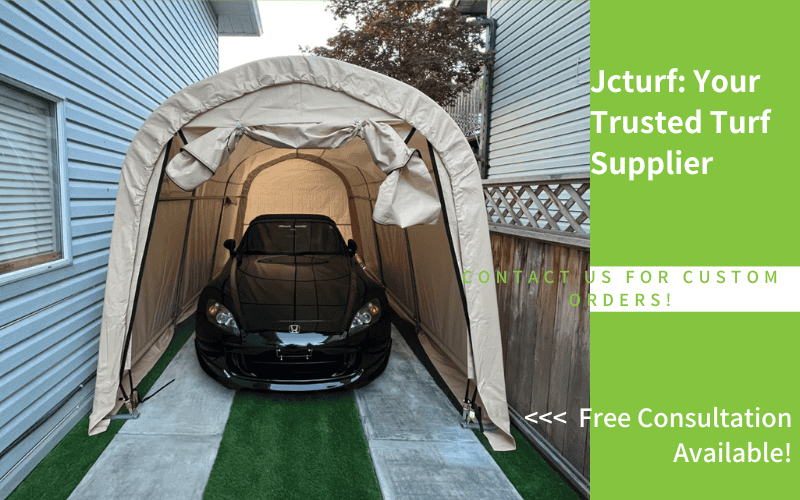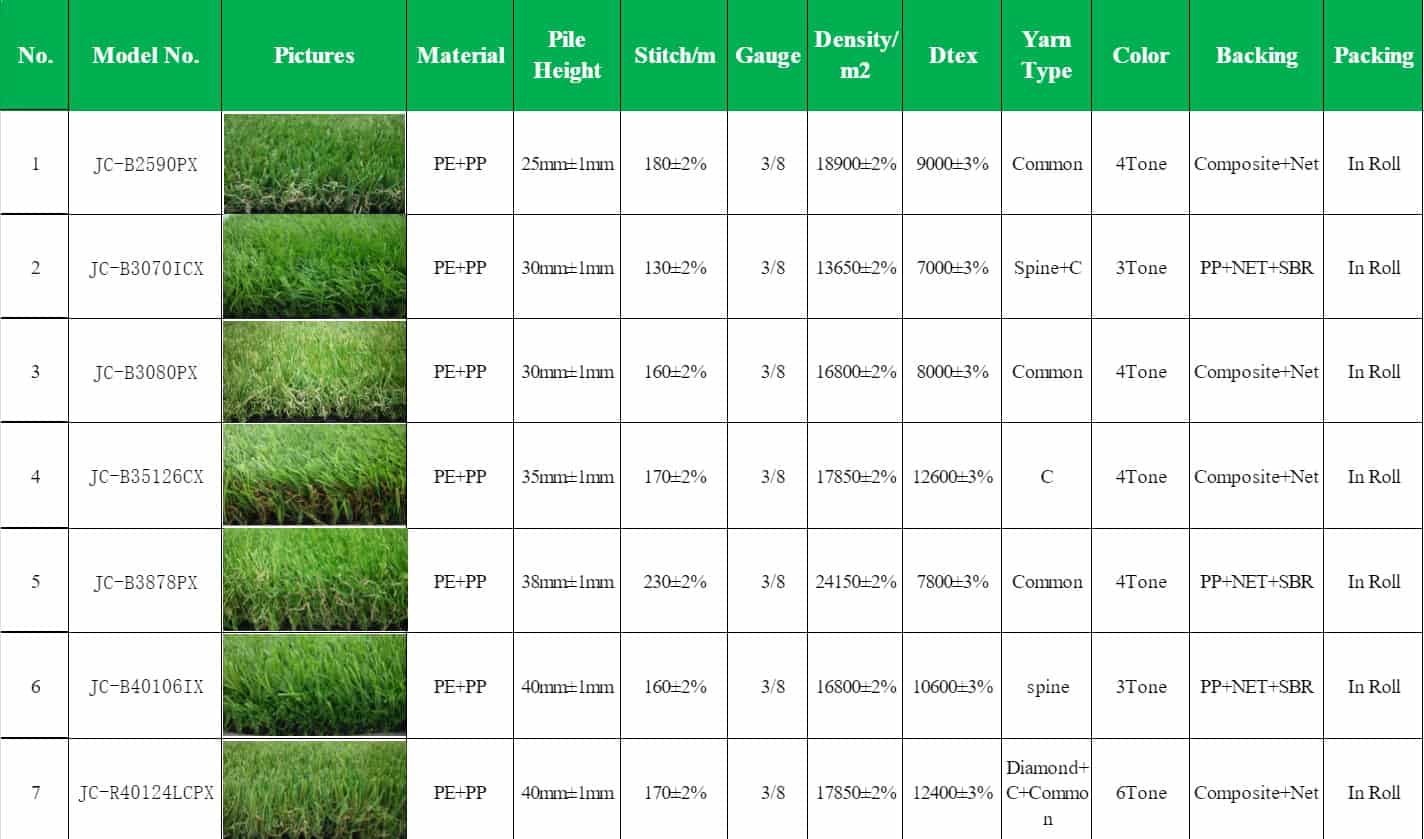Ever wondered if artificial grass can hold up under the weight of your car—or if it’s just a backyard novelty? You’re not alone. While synthetic turf has gained popularity in landscaping, its use on driveways still sparks questions. This guide answers them all.
We’ll start by explaining whether artificial grass can be safely used on a driveway. Then we’ll walk you through the installation process, outline the pros and cons, and show you some creative design ideas. Finally, we’ll help you assess whether a turf driveway fits your home’s needs and usage.
Ready to see if artificial grass is the smart surface upgrade your driveway needs? Let’s dig in.
Can You Use Artificial Grass on a Driveway?
Yes, you can use artificial grass on a driveway—as long as it’s installed correctly and designed for vehicle traffic. With the right materials and a proper sub-base, synthetic turf can hold up under the weight of cars without sinking or tearing. In this section, we’ll cover three key points. First, how safe it is to drive on artificial turf. Second, how much weight it can handle and how long it lasts. Finally, which types of turf are best suited for driveways.
Is It Safe to Drive on Artificial Grass?
Yes, you can drive on artificial grass—but only if it’s designed for that purpose. Driveway turf must be installed over a solid, compacted base, just like concrete or paving. This prevents shifting, sagging, or ruts from forming under vehicle weight.
Also, not all artificial grass is the same. Most turf made for landscaping or play areas won’t hold up under tire pressure. For driveways, you need turf with a short, dense pile and a strong backing. When combined with a stable base, this setup gives enough support for car traffic without compromising surface integrity.
In short: if you use the right materials and install them properly, artificial grass can be just as safe as pavers.
How Durable Is Artificial Grass Under Vehicle Weight?
High-quality artificial grass, installed on a stable base, can easily support the weight of standard passenger vehicles—typically up to 2.5 tons. Some turf systems with added reinforcement (like drainage grids or geotextile layers) can even handle light trucks and delivery vans.
Durability also depends on repeated use. While occasional parking causes little harm, constant heavy traffic, sharp turns, or abrupt stops can wear down the surface over time. Properly maintained turf can last 8 to 15 years on a driveway, depending on traffic level and installation quality.
To avoid damage, try to drive straight onto and off the turf, and avoid turning the wheels while stationary. Regular brushing and cleaning will also extend its usable life.
Which Types of Turf Are Suitable for Driveways?
Not all turf products are up to the task. For driveway use, look for these features:
- Short pile height (under 30mm): Less likely to flatten under weight.
- High-density stitching: Offers better compression resistance.
- Heavy-duty backing: Often double-layered or polyurethane-based.
- Permeability: Allows water to drain quickly to prevent buildup.
You might also consider turf specifically labeled for “traffic zones” or “pet/playground use”—these tend to be more rugged than decorative lawns.
Installation Tips for Artificial Grass Driveways
Installing artificial grass on a driveway isn’t the same as laying it on a backyard lawn. The materials, base, and methods must all be strong enough to handle the weight of vehicles. Whether you plan to do it yourself or hire a contractor, here are four key parts of the installation process that you need to get right: preparing the base, managing drainage, joining the turf securely, and deciding who should do the work.
Start With a Solid, Compacted Base
The foundation under your turf is everything. For a driveway, the base needs to be hard-packed and stable—think road base or crushed stone, not just sand or dirt.
A typical driveway sub-base includes:
- 4–6 inches of compacted Class II road base or crushed granite
- A layer of sharp sand (optional) for leveling
- Geotextile fabric to reduce weed growth and add stability
Without a proper base, the turf can shift, sink, or develop dips under tire pressure.
Plan for Effective Drainage
Artificial grass is water-permeable, but the base must also allow fast drainage. Poor drainage can lead to puddles, turf lifting, or base erosion, especially when combined with heavy car use.
Make sure:
- The sub-base is graded to promote runoff
- The turf backing has drainage holes
- There’s no pooling near seams or edges
Some installations add a perforated pipe system under the base for extra drainage, especially on large or low-slope driveways.
Secure Seams and Edges Carefully
Driveway turf takes more abuse than a backyard lawn, so weak seams won’t last. Use heavy-duty turf tape and adhesive for bonding turf rolls together. In high-traffic areas, mechanical fastening (like galvanized staples or turf nails) may be added for reinforcement.
For the edges, consider:
- Concrete curbing or metal edging strips for clean borders
- U-pins or composite edging if the turf meets soft landscape areas
The goal is to prevent shifting, curling, or unraveling over time.
DIY vs. Hiring a Professional
Installing turf on a driveway is possible as a DIY project, but it’s labor-intensive and unforgiving. You’ll need access to compacting equipment, the right materials, and enough precision to get slopes and seams right.
DIY may be an option if you:
- Have basic landscaping experience
- Are working on a small area (e.g. turf strips)
- Can rent or borrow the right tools
Hire a pro if:
- The driveway sees daily car use
- You’re installing over a large or uneven area
- You want long-term durability with warranties
A poorly installed turf driveway often leads to costly repairs. If in doubt, get a quote from a turf specialist—it may save you time and money in the long run.
Pros and Cons of Artificial Turf Driveways
Artificial turf can be a great alternative to traditional driveway materials—but like any solution, it comes with trade-offs. Here’s a balanced look at the benefits and drawbacks so you can decide if it’s the right fit for your needs.
Pros of Artificial Grass Driveways:
- Clean, modern appearance that stays green all year
- Low maintenance—no mowing, fertilizing, or watering required
- Good drainage when properly installed, reducing puddles and runoff
- Weed-resistant thanks to tight backing and barrier layers
- Can be combined with pavers or concrete for stylish hybrid designs
- Durable against UV rays, rain, and foot traffic
For homeowners looking to improve curb appeal without the upkeep of real grass or the hard look of all-concrete surfaces, turf can strike the perfect balance.
Cons of Artificial Grass Driveways:
- Can retain heat, especially in full sun or warmer regions
- Upfront cost is higher than plain gravel or concrete
- Not all turf is rated for heavy vehicles—wrong choice leads to damage
- May require brushing and infill maintenance in high-traffic areas
- Wheel turning while parked can cause fiber twisting or seam stress
It’s also important to note: artificial turf isn’t a structural surface. The durability largely depends on the sub-base quality and how the turf is used day to day.
How Does Turf Compare to Concrete or Pavers?
Turf driveways aren’t meant to replace all-concrete or paver systems, but to complement them. Turf adds softness, visual warmth, and water permeability—but it requires thoughtful planning. If you’re after a zero-maintenance, ultra-durable surface for constant car traffic, pavers or concrete may suit you better. If design, greening, and light-to-moderate use are your goals, turf can be a smart and stylish solution.
Creative Artificial Grass Driveway Ideas and Designs
Artificial grass gives you more design flexibility than traditional driveway materials. Whether you’re looking for a minimalist strip layout, a bold geometric grid, or something that flows around trees or pools, there’s a turf-based solution that fits. Below are some of the most effective—and visually appealing—ways to design an artificial grass driveway.
Concrete Strip Layout with Grass In-Between
One of the most popular designs uses two solid driving lanes made of concrete or stone, separated by turf. This setup keeps your tires on a firm surface while adding greenery to the layout. It’s clean, low-maintenance, and ideal for narrow driveways or homes with a modern aesthetic.
- Works well on sloped or narrow sites
- Easy to maintain, as cars don’t roll directly over the turf
- Creates a subtle “green ribbon” look
Turf Between Pavers: A Modern Grid
This design uses large concrete or stone pavers spaced evenly with synthetic turf joints. It’s ideal for homeowners who want a structured, modern layout without a full hardscape look. The pavers handle the weight; the turf softens the visual.
Design tips:
- Stick to square or rectangular pavers for clean symmetry
- Use darker or textured turf for contrast
- Choose a tight turf joint for a sleek finish
Full Driveway with Turf Borders or Inlays
If you prefer a traditional paved driveway but want to add some green, turf strips along the borders or in geometric inlays can enhance the space. It’s a great way to break up large concrete surfaces without compromising function.
Ideas include:
- Turf running along both sides of the driveway
- Grass bands between parking pads
- Patterns like diamonds or frames built into concrete sections
This approach adds design value with minimal changes to base structure.
Around Landscape Features: Pools, Trees, and Walkways
Artificial turf can be especially useful when your driveway borders other landscape elements. It connects different zones without the mess or upkeep of real grass.
Common applications:
- Wrapping turf around tree wells or planting beds
- Running turf alongside pool decks or patio edges
- Transition zones between driveway and front walkways
Turf helps soften the layout and ties the driveway visually into the surrounding landscape.
Creative Patterns and Shapes
Beyond functional layouts, some homeowners use turf as a design element itself. Patterns like chevron, herringbone, or curved bands can turn your driveway into a statement piece.
While these layouts require more planning and cutting, they can deliver a striking, high-end finish that’s hard to replicate with traditional materials.
Is Artificial Grass Driveway the Right Choice for You?
Artificial grass driveways offer real benefits—but they’re not the perfect solution for every home or homeowner. If you’re unsure whether turf is a smart choice for your driveway, consider the following factors before making a decision.
How Often Do You Use the Driveway?
If your driveway sees only light daily use—like one or two vehicles parked with little movement—turf can work well and hold up for years. But if you’re turning, reversing, or moving heavy vehicles often, you’ll need premium materials and expert installation. Frequent wheel pivoting in place may wear the surface faster than expected.
What’s Your Local Climate Like?
Artificial grass performs well in most climates, but with some trade-offs:
- In hot, sunny areas, turf can retain heat and feel warm to the touch, especially during summer afternoons.
- In wet or humid zones, drainage and base preparation become even more critical to prevent moisture buildup or mold.
- In freezing climates, turf should be installed with frost-resistant base layers to avoid shifting during freeze-thaw cycles.
Make sure the turf product you choose is UV-stable and climate-rated for your area.
Are You Focused on Aesthetics, Function, or Both?
If your goal is to soften the look of a hardscape, match the lawn, or add greenery to a minimalist design—turf is a powerful tool. It can make concrete-heavy spaces more welcoming. But if you’re focused only on durability under high vehicle traffic, a full concrete or paver surface may still be the better option.
Do You Want Low Maintenance—or No Maintenance?
Turf does reduce upkeep compared to natural grass, but it’s not 100% maintenance-free. You’ll still need to:
- Brush or fluff flattened areas from time to time
- Rinse off dirt or debris, especially if shaded or tree-covered
- Occasionally check for seam separation or edge curling
If you’re expecting zero involvement over the years, managing expectations is key.
Is It Within Your Budget?
Installing turf on a driveway is often more expensive than regular lawn turf due to stronger materials, extra base work, and tighter installation tolerances. However, the long-term savings in water, mowing, and repair costs can balance that investment—especially in areas where green space is hard to maintain.
Conclusion: Fit Comes Down to Priorities
Artificial grass driveways work best for homeowners who want a clean, modern look with moderate vehicle use and reduced yard upkeep. If you live in a suitable climate, have proper drainage, and choose high-quality materials, turf can be a lasting and stylish solution. But if your top concern is heavy-duty use with zero maintenance, traditional hardscaping may still be the safer route.
Can You Wash Your Car on an Artificial Grass Driveway?
Yes, you can wash your car on an artificial grass driveway as long as the turf is properly installed with drainage underneath. The water will drain through the turf backing into the base layer. Just avoid using harsh chemicals that might damage the fibers or backing.
Will Driving Over Turf Damage It?
No, driving over artificial grass won’t damage it—if the turf is rated for vehicle use and installed on a compacted base. Low-quality turf or soft soil underneath may cause ruts, folds, or seam failures over time.
What’s the Difference Between Driveway Turf and Indoor Putting Green Turf?
Driveway turf is engineered for heavy load-bearing and outdoor weather. It has shorter pile height, dense stitching, and strong backing. Indoor putting green turf is designed for smooth ball roll and light foot traffic—never for vehicles or harsh conditions.
How Long Does a Turf Driveway Last?
An artificial grass driveway can last 8 to 15 years with proper installation and regular upkeep. Longevity depends on traffic level, climate, and the quality of turf materials used.


